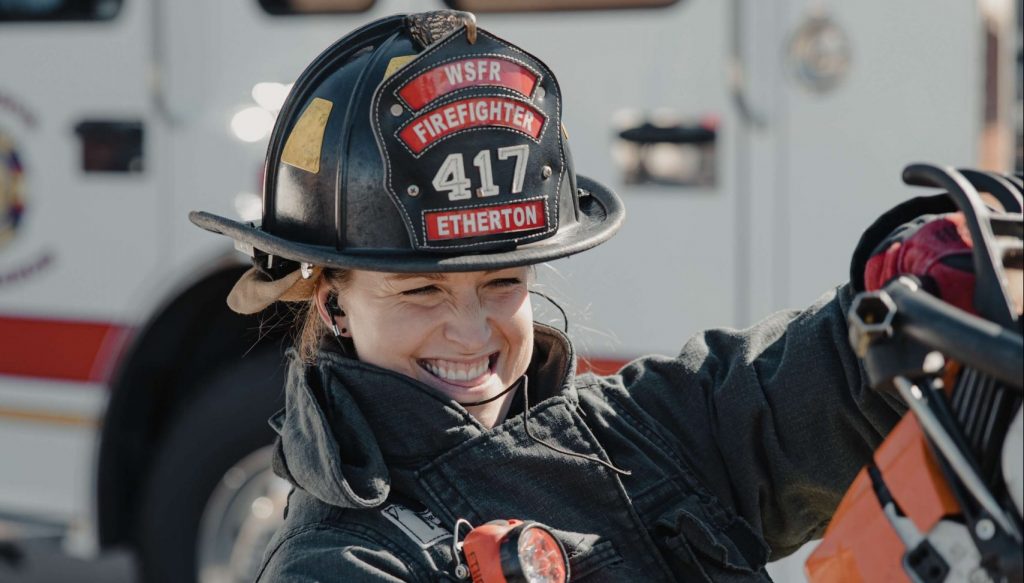Student-centric advice and objective recommendations
Higher education has never been more confusing or expensive. Our goal is to help you navigate the very big decisions related to higher ed with objective information and expert advice. Each piece of content on the site is original, based on extensive research, and reviewed by multiple editors, including a subject matter expert. This ensures that all of our content is up-to-date, useful, accurate, and thorough.
Our reviews and recommendations are based on extensive research, testing, and feedback. We may receive commission from links on our website, but that doesn’t affect our editors’ opinions. Our marketing partners don’t review, approve or endorse our editorial content. It’s accurate to the best of our knowledge when posted. You can find a complete list of our partners here.
Guide to How to Become a Firefighter
 By
Zach Skillings
By
Zach Skillings 
Zach Skillings is the Scholarships360 Newsletter Editor. He specializes in college admissions and strives to answer important questions about higher education. When he’s not contributing to Scholarships360, Zach writes about travel, music, film, and culture. His work has been published in Our State Magazine, Ladygunn Magazine, The Nocturnal Times, and The Lexington Dispatch. Zach graduated from Elon University with a degree in Cinema and Television Arts.
Full BioLearn about our editorial policies

Maria Geiger is Director of Content at Scholarships360. She is a former online educational technology instructor and adjunct writing instructor. In addition to education reform, Maria’s interests include viewpoint diversity, blended/flipped learning, digital communication, and integrating media/web tools into the curriculum to better facilitate student engagement. Maria earned both a B.A. and an M.A. in English Literature from Monmouth University, an M. Ed. in Education from Monmouth University, and a Virtual Online Teaching Certificate (VOLT) from the University of Pennsylvania.
Full BioLearn about our editorial policies

Firefighters provide an incredibly valuable service to our communities. Not only do they fight fires, but they also respond to medical emergencies and perform search and rescue efforts. Breaking into the firefighting field can be highly competitive, but it’s entirely possible with enough hard work, passion, and determination. Keep reading to learn how to become a firefighter!
Related: Top firefighter scholarships
A brief overview
For the most part becoming a firefighter will involve meeting a few basic almost universal requirements. We’ve listed them below!
- Be at least 18 years old
- Possess a high school diploma (or GED equivalent)
- Possess a valid driver’s license
In addition to this list, you’ll also need to receive the proper training and certifications, pass a physical exam and potentially a few other things that your department may specifically require.
Training Routes
Now let’s talk about what the order of events above looks like in action. You’ll likely take one of two paths, either you’ll receive all your fire training before you apply to a department and you’ll simply apply to go straight to the job, or you’ll apply to your city’s fire academy. Fire academies will typically take you with little to no experience and will provide you with all the training you need, as well as guarantee you a job in that city once you pass all your training. Let’s talk more about them below!
Fire Academies
If you live in a large city, or near a large city, it’s likely that they have their own fire academy. A fire academy is just what it sounds like, a school for firefighters. Here you will learn everything you need to know about fighting fires! These academies can vary in length, but you should plan to spend at least three months going through full time training. During this time you’ll earn your fire one and fire two certifications. While these academies usually are in larger cities, they will sometimes be used by smaller surrounding cities as well.
- Apply: This may be a more thorough process than you’re anticipating. Applying to work for a city can involve taking a civil service exam, filling out an application, passing background checks, passing a physical agility test, medical exams and more. This process can take up to a year to complete.
- Attend the academy: These academies can vary in length, but you should plan to spend at least three months going through full time training, which means you likely won’t be able to work anywhere else. However, cadets are usually paid for this training. During this time you’ll typically earn your fire one and fire two certifications.
- Start work: Once you successfully complete the academy you’ll start working as a firefighter. Your department may have something like an apprenticeship program that will continue to teach you skills as you work, but again, this will vary based on the department you work for.
Fire academy alternatives
If you aren’t from a large city, or live near one, your fire training may look a bit different. So, let’s talk about what this process might look like!
- Get your certifications: Even if you plan to go work for a volunteer fire department, you still need to have some level of fire education. So, attending a community college or a trade school to get your fire one and two certifications may very well be worth it.
- Gain experience: Gaining experience as a volunteer firefighter or through other outlets isn’t absolutely necessary, but having more experience certainly never hurts anybody.
- Start applying: Once you have the right certifications, and you’ve gained some experience, you can apply to departments. Firefighting can be competitive, so this process may take some time.
- Go through the hiring process: Getting hired somewhere may take a few weeks, or months. They may require you to pass an agility test, a physical exam, and even a drug test. Depending on where you apply, you’ll probably do some additional training on the job once you are hired at a department.
What are Fire 1 and Fire 2 certifications?
Fire 1 and Fire 2 are two certifications that you’ll obtain either before applying, or that your department will help you get through an academy once you’ve been hired. These certifications teach you all that you need to know about firefighting, hazardous materials, responding to emergent situations and more. You’ll need to pass exams at the end of your training in order to receive your official certifications from the National Fire Protection Agency.
EMS education
Regardless of what level of education you pursue, you’ll need to obtain your Emergency Medical Technician (EMT) certification at some point along the way, and possibly your Paramedic certification. Along with putting out fires, firefighters must also act as first responders to accident scenes and other emergency situations. That’s why nearly all fire departments require employees to become certified EMTs. This typically occurs either during the candidacy process or immediately after hiring. However, getting your EMT or Paramedic certification ahead of the application process can give you a big edge over your competition. EMT and paramedic training can usually be obtained at trade schools, community colleges, hospitals and other organizations.
The schedule of a firefighter
Most fire departments have moved to a schedule that requires 24 hour shifts, followed by 48 to 72 hours off. So, you’ll likely only need to work 2-3 days per week! This may seem like a lot, and it certainly is, but working 24 hours doesn’t mean you’ll actually have to be working that whole time. For the majority of your day you will complete daily tasks around the firehouse, have your meals together and respond to calls when they come in. Towards the end of the day you’ll slow down and be able to go to bed, only having to wake up if there is a call to respond to.
What to do if you can’t get hired
Consider starting at the volunteer level
Becoming a volunteer firefighter is an excellent way to get your foot in the door of this competitive field. Volunteers perform many of the same duties as career firefighters, including responding to fire outbreaks and performing search and rescue efforts.
If you’re interested in pursuing this route, contact your local or neighboring fire department about current or future volunteer openings. While volunteering isn’t the only way to become a paid firefighter, it’s a great place to start!
Look in to further schooling
You may also want to look into further EMS education or fire education to make yourself look more appealing as a candidate. Some fire departments may be willing to even reimburse you for this training once you are hired on and working full time. Pursuing your EMT or paramedic certification is certainly something that will benefit you in this process!
Further education options
For those really looking to further their education in firefighting, or advance into higher administrative roles in a department, you may consider getting a certificate or associate in fire science, or even a bachelor’s degree in it. Again, these things can typically be completed at a community college, though a bachelor’s may only be available at some. After getting your bachelor’s, you can even go on to earn a master’s degree in fire science if you’re seeking top-tier supervisory work.
Civil Service Exam
Above we briefly mentioned that you may need to take a civil service exam or a written exam of sorts. This test will help determine your rank on the hiring list. The higher you score, the better chance you’ll have of getting an interview. The exam is a test of general knowledge, covering topics such as math, reading comprehension, and problem solving. You’ll want to pay special attention to when this test is going to be administered, as it usually is only available for one or two dates and times, and missing it may disqualify you from the hiring process.
Interview
Before we wrap up, let’s talk about the interview process for just a minute. If you make it to the interview stage, you can expect to be interviewed by a panel of 3-7 current firefighters. Interviews last anywhere from 15 to 45 minutes. Prepare to answer questions about your career goals and why you want to be a firefighter. Candidates that make it past this initial interview must conduct a final interview with the fire department chief. This interview allows the chief to get to know you on a personal level. Becoming a firefighter is a serious matter, so you can expect the interview process to be just the same!
Finances for a firefighting education
If you are hired on to attend a fire academy, you will not have to pay for this school. In fact, most fire academies pay their cadets while they are in training because it typically requires you to train from 9-5 Monday through Friday.
If you choose to complete your fire one and two certifications or any EMS education on your own, you’ll typically do this at a community college or trade school. This means that many of the same funding options, like loans, grants and scholarships will be available to you. Once you’re hired somewhere, it’s also always worth inquiring about if the department will reimburse you for any of the training you’ve paid to complete.
For undergraduate programs, you can use the Pell Grant to get need-based aid per semester. Additionally, as a public service worker, you can qualify for public service loan forgiveness. This doesn’t help you pay your way through the program, but forgives any remaining federal loans after ten years of paying them back.
Frequently asked questions about how to become a firefighter
How much do firefighters make?
What state pays the best for firefighting?
Why do firefighters make so much?


